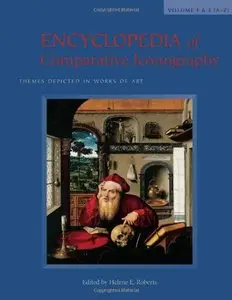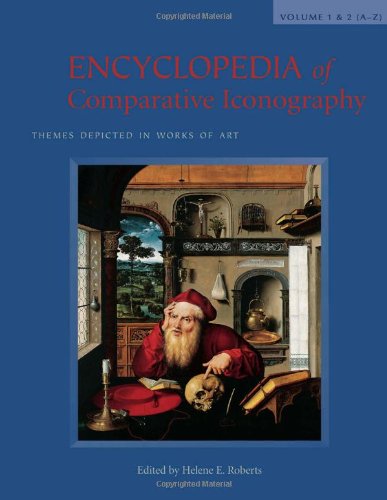Encyclopedia of Comparative Iconography: Themes Depicted in Works of Art (2 Vol. Set) by Helene E. Roberts
English | 1998 | ISBN: 1579580092 | 1150 pages | PDF | 19 MB
English | 1998 | ISBN: 1579580092 | 1150 pages | PDF | 19 MB
Many art reference sources identify works of art by title, artist, or medium. Identification on the basis of theme or subject has always been more problematic. It is also an approach that many students, teachers, and other library users interested in art wish to pursue. Reference sources taking this approach tend to be narrow in focus, such as those on religious iconography or depictions of saints. Encyclopedia of Comparative Iconography (ECI) expands the scope of the thematic guide to art to include mythological, biblical, and literary themes that have been represented in art of all periods and media. Roberts is editor of Visual Resources: An International Journal of Documentation and the book series Documenting the Image (Gordon and Breach).
ECI includes 119 signed, alphabetically arranged essays on actions (harvesting, kiss/kissing), situations (upside down, widowhood), and concepts (whiteness, calumny). Entries were written by 42 prominent contributors, most of whom are faculty in art history, classics, archaeology, or literature at universities in the U.S. Many of the contributors are full professors, department chairs, and authors of their own books. Among them are Diane Apostolos-Cappadona, author of The Encyclopedia of Women in Religious Art [RBB S 15 97].
Each essay is divided into sections on motifs and iconographic narratives that constitute subdivisions of the essay. For example, drunkenness/intoxication includes sections on Dionysius/Bacchus; Lapiths and Centaurs; the drunkenness of Noah, Judith, and Holofernes; and artists and alcohol in the twentieth century and in China. The essay addresses narratives that are the sources of the images, historical background, symbolism, variations in presentation, and how the theme evolved over time. Each section includes references to works of art depicting the theme. These are also listed by section and then in chronological order in a list of Selected Works of Art at the end of the essay. The theme Bacchanales and Related Subjects, for example, is depicted in 15 works from the Barberini Faun (c. 220 B.C.) to Picasso's Feast of the Fauns (1957). These references include artist, title, medium, date, and location (if known). Each essay includes one full-page black-and-white photograph illustrating a representative work of art. The Feast of the Fauns, for example, illustrates drunkenness/intoxication. A list of further reading includes books and periodical articles.
Seven indexes to terms discussed in the entries increase the likelihood that the user will find references to the subject being sought. An Index of Ancient Mythological and Historical Personages, Places, and Concepts, and an Index of Judeo-Christian Personages, Places, and Concepts help the user who is interested in a particular place or the narratives of particular characters, but isn't sure how themes relating to them are categorized. These are followed by an Index of References to the Bible and Other Sacred Books; an Index of Other Cultures, Religions, and Mythologies; an alphabetical Index of Artists and Works of Art; and an Index of Authors, Literary Texts, Composers, Filmmakers, and Folktales, which includes references from classical to contemporary, including Aesop, Benjamin Franklin, the musical Hair, and Walt Disney. A final Index of Other Names and Terms includes topics that appear in the essays but are not themselves mythological, religious, or literary, such as brothels, dogs, and puzzles.
In addition to the further reading included with each essay, the encyclopedia provides a bibliography of approximately 300 reference books in English and other European languages. The list includes the classics upon which scholars have traditionally relied for thematic information, such as Gertrud Schiller's Iconography of Christian Art (New York Graphic Society, 1971), George Ferguson's Signs and Symbols in Christian Art (Oxford, 1954), and James Hall's Dictionary of Subjects and Symbols in Art (Harper, 1979).
Editor Roberts points out that "there is no other reference book that uses the comparative method to describe the use of iconography in art that is organized from the point of view of actions, situations, or concepts rather than by the personages in mythical, biblical, or literary narratives." There is no doubt that many users seek access to artwork by subject and that few tools exist to aid them in their quests. Most users seeking simple depictions of an object (a snake or a volcano) have found Marsha Appel's Illustration Index I-VIII (Scarecrow, 1980^-1998; see Reference Books in Brief on p.362) useful. Those pursuing Christian iconography have relied on Schiller's Iconography of Christian Art. This comprehensive, two-volume work still sets the standard for Christian iconography with, for example, more than 80 pages and numerous reproductions devoted to the Crucifixion, as opposed to seven pages and one reproduction in ECI. The broad thematic arrangement and comparative analysis of classical and contemporary, as well as Christian themes, make ECI a complementary resource to Schiller.
There is also no doubt that ECI is thorough, scholarly, and effectively arranged with its numerous access points. Its lists of selected works of art for each theme are especially valuable, as this feature is not offered in some sources, such as Ferguson and Hall. The extent of its usefulness will depend on whether the desired subject is among the 119 themes included. The encyclopedia will be less useful to those trying to find artwork depicting literal subjects such as snakes or teapots–and any art librarian can tell you that there are requests like this–than for those seeking conceptual discussions of broad themes. These users will find ECI a treasure (discussed under abundance and luxury). Highly recommended for art, academic, and large public libraries.



